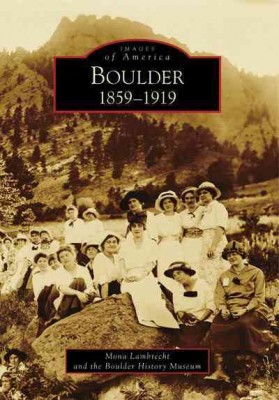| Boulder: 1859-1919 Contributor(s): Lambrecht, Mona (Author), Boulder History Museum (Author) |
|
 |
ISBN: 0738558907 ISBN-13: 9780738558905 Publisher: Arcadia Publishing (SC) OUR PRICE: $22.49 Product Type: Paperback Published: November 2008 Annotation: Born out of the 1859 Pikes Peak gold rush, Boulder sits along the Front Range where the Rocky Mountains meet the plains. Discoveries of gold, silver, telluride, and coal nearby put the little supply town on the map, and early miners, farmers, and businessmen prospered there. The railroadas arrival in 1873 brought more newcomers who cultivated a diverse community full of new businesses, social organizations, and schools, and the town flourished despite the social problems and economic fluctuations that were typical of early mining towns. By the 1890s, education, health, and tourism had become significant to Boulderas economic development, a pattern that continues to this day. Great change came about during the early 1900s in the form of a citywide alcohol prohibition, the influenza epidemic, and the closure of the aSwitzerland Traila railroad in 1919, but Boulder weathered these difficult times even as it witnessed the end of the great railroading era. |
| Additional Information |
| BISAC Categories: - History | United States - State & Local - West (ak, Ca, Co, Hi, Id, Mt, Nv, Ut, Wy) - Photography | Subjects & Themes - Regional (see Also Travel - Pictorials) - Travel | Pictorials (see Also Photography - Subjects & Themes - Regional) |
| Dewey: 978 |
| LCCN: 2008928326 |
| Series: Images of America (Arcadia Publishing) |
| Physical Information: 0.5" H x 6.4" W x 9.1" (0.85 lbs) 128 pages |
| Themes: - Locality - Boulder-Longmont, Colorado - Geographic Orientation - Colorado - Cultural Region - Western U.S. - Chronological Period - 1851-1899 - Chronological Period - 1900-1919 |
| Descriptions, Reviews, Etc. |
| Publisher Description: Born out of the 1859 Pikes Peak gold rush, Boulder sits along the Front Range where the Rocky Mountains meet the plains. Discoveries of gold, silver, telluride, and coal nearby put the little supply town on the map, and early miners, farmers, and businessmen prospered there. The railroad s arrival in 1873 brought more newcomers who cultivated a diverse community full of new businesses, social organizations, and schools, and the town flourished despite the social problems and economic fluctuations that were typical of early mining towns. By the 1890s, education, health, and tourism had become significant to Boulder s economic development, a pattern that continues to this day. Great change came about during the early 1900s in the form of a citywide alcohol prohibition, the influenza epidemic, and the closure of the Switzerland Trail railroad in 1919, but Boulder weathered these difficult times even as it witnessed the end of the great railroading era." |
Contributor Bio(s): Lambrecht, Mona: - Historian, writer, and genealogist Mona Lambrecht grew up in Boulder, and the town s early history and people continue to captivate her. A public historian with a graphic design background, Lambrecht specializes in community histories and visual history projects. For this book, Lambrecht collaborated with the Boulder History Museum to present a unique selection of the museum s extensive collection of historic photographs. |